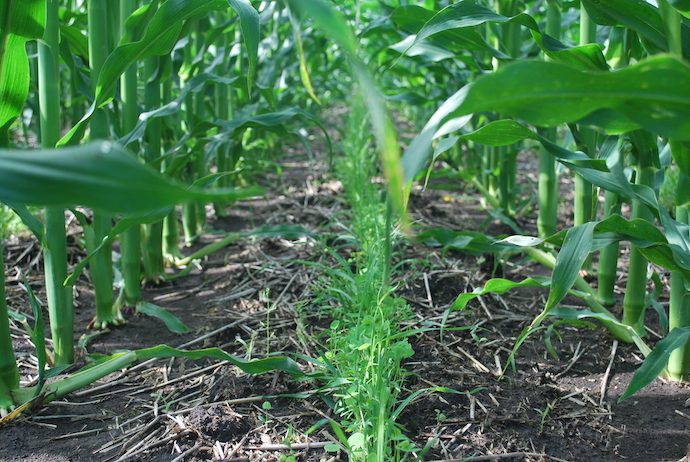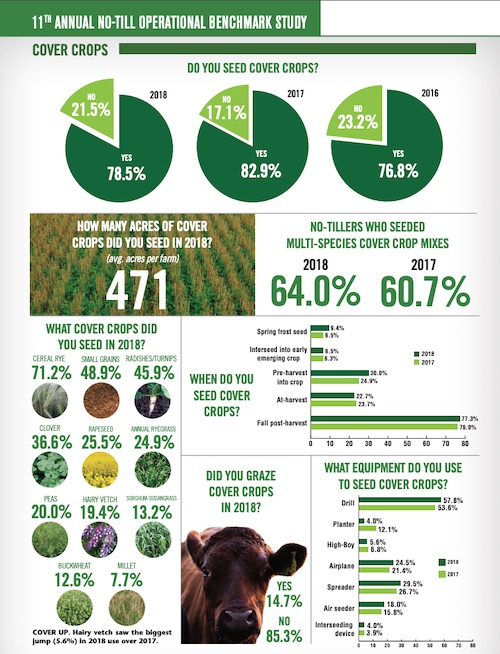The average No-Till Farmer reader seeded slightly more cover crop acres in 2018 than during the previous year — although the percentage of readers who seeded covers took a slight dip, according to the most recent No-Till Farmer Operational Benchmark Study.
Data shared by more than 400 farmers who participated in the 11th annual survey — an industry exclusive — showed no-tillers seeded 472 acres of cover crops last year. The average for 2017 was 451 acres.
It appears No-Till Farmer readers surveyed for the study are well ahead of the national curve. The 2012 Census of Agriculture reported an average of 77 acres of cover crops seeded per farm in the U.S.
New figures from the Census of Agriculture are expected to be released in April.
Some 79% of readers seeded cover crops in 2018, down from 83% in 2017. It was the first decline in cover crop use since the 2011 survey.
To put this in perspective, in 2009 only 40% of no-tillers said they seeded covers. Since then the number of growers seeding covers has grown by an average of 6 points per year.
Anecdotally, many readers shared they had difficulty getting cover crops seeded in time last year due to weather issues and late harvest. The challenges are prompting some of them to look into other seeding methods, such as aerial seeding or interseeding into standing crops.
Cereal Rye Dominates
Cereal rye was the dominant choice as a species in 2018 with 73% of respondents using it, followed by small grains at 50%, radish/turnip at 47%, clover at 38% and annual ryegrass and rapeseed at 26%.
Peas (21%) and vetch (20%) also enjoyed popularity. There was little change in the top species used in 2018 vs. the previous year, with cereal rye, clover, radishes, cereals/oats, annual ryegrass and peas dominating.
Some 64% of no-tillers seeded a multi-species cover crop mix last year, up from 61% in 2018 and similar to data from 2017 and 2016.
Only about 14.7% of respondents were grazing livestock on cover crops in 2018, although based on the interest seen at events and reader data this is likely to increase in the coming years.
Timing is Everything
When asked when cover crops were seeded in 2018, 76% said fall post-harvest and 22% at harvest (within 24 hours), while 30% did some pre-harvest seeding into crops.
About 7% interseeded covers into an early-emerging crop and 9% did spring frost seeding. There was a 4-point jump in 2018 in the percentage of those seeding covers pre-harvest and nearly 3-point increase with spring frost seeding.
When it comes to equipment used to seed cover crops, 57% used a drill (up 4 points from 2017), 30% used a spreader (up 4 points), 24% aerial application (up 3 points) and 18% utilized an air seeder (up 3 points).
Only 4-5% of no-tillers used a planter, interseeding device or a highboy in 2018. Since 2017, cover crop application by airplane, spreader and air seeder has seen consistent increases.
When Did You Seed Cover Crops in 2018?
| Spring Frost Seed |
Interseed in Early Emerging Crop |
Pre-Harvest into Crop |
At Harvest | Post Harvest | |
| Appalachia | 0 | 0 | 29% | 29% | 88% |
| Eastern Corn Belt | 8% | 5% | 40% | 27% | 75% |
| Western Corn Belt | 11% | 5% | 34% | 14% | 74% |
| Great Lakes | 12% | 15% | 26% | 21% | 76% |
| Northeast | 3% | 6% | 3% | 25% | 84% |
| Northern Plains | 23% | 0% | 31% | 31% | 62% |
| Southern Plains | 20% | 0% | 33% | 7% | 80% |
Source: 11th Annual No-Till Farmer Benchmark Study
The timing for seeding cover crops varies depending on the region and weather conditions, according to those participating in the No-Till Farmer Benchmark Study. The majority of no-tillers are seeding covers post-harvest.
The Story by Region
Editors also broke out cover crop application and methods by U.S. regions — Appalachia, Great Lakes, Northeast, Eastern and Western Corn Belt, Northern and Southern Plains — and found these interesting points:
- The percentage of growers seeding cereal rye (38%) in the Northern Plains was much lower than other regions of the U.S. With the Northern Plains excluded, the average was 73%.
- Annual ryegrass was seeded by 36% of growers in the Eastern Corn Belt, 11 points higher than the next highest region, the Northeast, at 28%. On average at least 21% of no-tillers in these regions seeded annual ryegrass.
- About 29% of no-tillers in the Western Corn Belt used vetch, 7 points higher or more than the next-highest regions.
- Radish and clover are very popular: An average of 39% of growers across all regions seeded clover in 2018 and 42% applied radish/turnip in their cover crop program.
- The use of wheat/oats as a cover crop in Appalachia (60%) outpaced the next highest region by 16 points.
- Rapeseed (38%) was most popular in the Eastern Corn Belt, followed by the Northern and Southern Plains at 31% and Western Corn Belt at 29%.
- Some 49-52% of growers in Appalachia, Eastern and Western Corn Belt, Great Lakes and the Northeast seeded cover crop mixes last year.
- The Western Corn Belt led all regions in no-tillers grazing cattle on cover crops at 21%, followed by the Southern Plains at 19%. All other regions were 10% or lower.
- Spring frost-seeding of covers was most popular among no-tillers in the Northern Plains at 23%.
- Great Lakes no-tillers led the way in interseeding covers at 15%, and the Eastern Corn Belt had the most pre-harvest seeders of covers at 40%.
- The Northern Plains (31%) had the highest percentage of seeding covers at harvest, followed closely by Appalachia at 29%.
- Post-harvest cover crop seeding remains popular across geographies, with an average of 77% of no-tillers using the practice last year. Appalachia, the Northeast and Southern Plains all topped 80% of no-tillers employing the practice.
- Aerial seeding was most popular with no-tillers in the Eastern Corn Belt (35%), Western Corn Belt (34%) and Appalachia (28%).
- Some 54% of Northern Plains no-tillers favored air seeders for seeding covers, more than double the next-highest region.
- At 78%, Appalachia had the highest percentage of no-tillers using a drill to seed covers, followed by the Southern Plains (75%) and the Great Lakes, Appalachia and Western Corn Belt all eclipsing 60%.
- On average, 32% of no-tillers used a spreader to distribute cover crop seed in 2018, with a high of 39% in Appalachia and 38% in the Northeast.
What Type of Equipment Do You Apply Cover Crops With in 2018?
| Drill | Planter | Air Seeder | High-Boy | Aerial | Spreader | Interseeder | |
| Appalachia | 66% | 5% | 22% | 0% | 28% | 39% | 5% |
| Eastern Corn Belt | 51% | 8% | 15% | 10% | 35% | 34% | 5% |
| Western Corn Belt | 60% | 2% | 11% | 2% | 34% | 24% | 2% |
| Great Lakes | 61% | 5% | 16% | 5% | 18% | 35% | 7% |
| Northeast | 78% | 0% | 3% | 3% | 3% | 38% | 3% |
| Northern Plains | 23% | 0% | 54% | 0% | 23% | 23% | 0% |
| Southern Plains | 75% | 0% | 19% | 0% | 13% | 6% | 0% |
Source: 11th Annual No-Till Farmer Benchmark Study
While air seeders are the most popular machine for cover crop seeding in the Northern Plains, drills, spreaders and aerial seeding were also heavily utilized by no-tillers further east.





